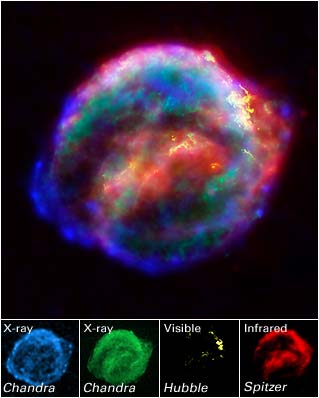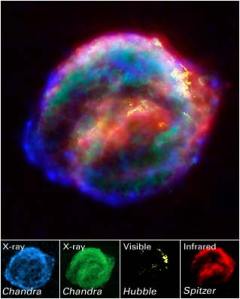
Hubble, Chandra, and Spitzer Unveil Kepler’s Supernova
Four hundred years ago, sky watchers, including the famous astronomer Johannes Kepler, were startled by the sudden appearance of a "new star" in the western sky, rivaling the brilliance of the nearby planets. Now, astronomers using NASA's three Great Observatories are unraveling the mysteries of the expanding remains of Kepler's supernova, the last such object seen to explode in our Milky Way galaxy. When a new star appeared alongside Jupiter, Mars, and Saturn on Oct. 9, 1604, observers could use only their eyes to study it. The telescope would not be invented for another four years. Modern-day astronomers, on the other hand, have the combined abilities of the Spitzer Space Telescope, the Hubble Space Telescope, and the Chandra X-ray Observatory at their disposal. A team of astronomers, led by Ravi Sankrit and William Blair of Johns Hopkins University in Baltimore, Md., are using the Great Observatories to analyze the remains, called Kepler's supernova remnant, in infrared radiation, visible light, and X-rays. The combined image unveils a bubble-shaped shroud of gas and dust that is 14 light-years wide and is expanding at 4 million miles per hour (2,000 kilometers per second). Observations from each telescope highlight distinct features of the supernova remnant, a fast-moving shell of iron-rich material from the exploded star, surrounded by an expanding shock wave that is sweeping up interstellar gas and dust. "Multiwavelength studies are absolutely essential for putting together a complete picture of how supernova remnants evolve," said Sankrit, an associate research scientist in the Center for Astrophysical Sciences at Johns Hopkins and the lead astronomer on the Hubble observations. "The glow from young remnants, such as Kepler's supernova remnant, comes from several components. Each component shows up best at different wavelengths." "For instance, the infrared data are dominated by heated interstellar dust, while optical and X-ray observations sample different temperatures of gas," added Blair, a research professor in the Physics and Astronomy Department at Johns Hopkins, and the lead astronomer on the Spitzer observations. "A range of observations is needed to help us understand the complex relationship that exists among the various components." The explosion of a star is a catastrophic event. The blast rips the star apart and unleashes a roughly spherical shock wave that expands outward at more than 22 million miles per hour (10,000 kilometers per second), like an interstellar tsunami. This wave spreads out into surrounding space, sweeping up any tenuous interstellar gas and dust into an expanding shell. In certain cases, the surrounding regions include material shed by the progenitor star in a stellar wind before the explosion, in earlier phases of its evolution. The stellar ejecta from the explosion initially trails behind the shock wave but eventually catches up with the inner edge of the shell and is heated to X-ray temperatures. Visible-light images from the Hubble telescope's Advanced Camera for Surveys reveal where the supernova shock wave is slamming into the densest regions of surrounding gas. The bright glowing knots are dense clumps that form behind the shock wave. As the shock plows into material lost from the progenitor star, instabilities left in its wake cause the swept-up gas to fragment into clumps. This clumping process is similar to the patterns made by oil and vinegar (a mix of two liquids of different densities) in a shaken bottle of salad dressing. The Hubble data also show thin filaments of gas that look like rippled sheets seen edge-on. These filaments reveal where the shock wave is encountering lower-density, more uniform interstellar material. Sankrit and Blair also compared their Hubble observations with those taken with ground-based telescopes to obtain a more accurate distance to the supernova remnant of about 13,000 light-years. The astronomers used the Spitzer telescope to probe the material that radiates in infrared light. These observations show heated microscopic dust particles that have been swept up by the supernova shock wave. The Spitzer data are brightest in the densest regions seen by the Hubble telescope. Whereas Hubble sees only the brightest, densest regions, the Spitzer telescope is sensitive enough to detect the entire expanding shock wave, a spherical cloud of material. Recent spectroscopic observations from Spitzer also reveal information about the chemical composition and physical environment of the expanding clouds of gas and dust that were ejected into space. This dust is similar to dust that was part of the cloud of dust and gas that condensed to form the Sun and planets in our solar system. The Chandra X-ray data show regions of very hot gas. The hottest gas (higher-energy X-rays) is located primarily in the regions directly behind the shock front. These regions also show up in the Hubble observations, and also align with the faint rim of glowing material seen in the Spitzer data. Cooler X-ray gas (lower-energy X-rays) resides in a thick interior shell and marks the location of heated material expelled from the exploded star. In some other supernova remnants, the ejecta also can be seen in visible light, but in Kepler it is seen only in X-rays. This broad study of the supernova remnant also may help astronomers identify the type of star that produced the explosion. Supernovas arise from two very different types of stars: low-mass, white-dwarf stars and massive stars. Of the six known supernovas in our Milky Way over the last 1,000 years, Kepler's supernova is the only one for which astronomers are uncertain of the type of star that exploded. By combining information from all three Great Observatories, astronomers are obtaining a much clearer picture of Kepler's supernova remnant. "It's really a situation where the total is greater than the sum of the parts," Blair said. "When the analysis is complete, we will be able to answer several important questions about this enigmatic object." The Space Telescope Science Institute (STScI) is operated by the Association of Universities for Research in Astronomy, Inc. (AURA), for NASA, under contract with the Goddard Space Flight Center, Greenbelt, Md. The Hubble Space Telescope is a project of international cooperation between NASA and the European Space Agency (ESA). NASA's Marshall Space Flight Center, Huntsville, Ala., manages the Chandra program for NASA's Office of Space Science, Washington. Northrop Grumman of Redondo Beach, Calif., formerly TRW, Inc., was the prime development contractor for the observatory. The Smithsonian Astrophysical Observatory controls science and flight operations from the Chandra X-ray Center in Cambridge, Mass. JPL manages the Spitzer Space Telescope mission for NASA's Science Mission Directorate, Washington, D.C. Science operations are conducted at the Spitzer Science Center at the California Institute of Technology in Pasadena. JPL is a division of Caltech. Spitzer's Infrared Array Camera was built by NASA Goddard Space Flight Center, Greenbelt, Md. BACKGROUND INFORMATION: KEPLER HISTORY Four centuries ago, an evening's entertainment was as simple as stepping out to gaze at the night sky. But among the world's many star watchers one man stood apart. Johannes Kepler (1571-1630) was a mathematician and physicist who not only observed, but also sought to explain the celestial dance above. A rather frail young man, the exceptionally talented Kepler turned to mathematics and the study of the heavens early on. When he was six, his mother pointed out a comet visible in the night sky. When Kepler was nine, his father took him out one night under the stars to observe a lunar eclipse. These events both made a vivid impression on his youthful mind and turned him toward a life oriented to the study of astronomy. Kepler used simple mathematics to formulate three laws of planetary motion. Kepler's First Law stated that planets move in elliptical paths around the Sun. He also discovered that planets move proportionally faster in their orbits when they are closer to the Sun, and this became Kepler's Second Law. Finally, Kepler's Third Law explained the relationship between the distance of a planet from the sun and the amount of time it took to orbit the Sun. Together these laws of celestial mechanics revolutionized astronomy. "The era in which Kepler lived was one of tremendous upheaval and change," said Dr. Dan Lewis, curator of the history of science and technology at the Huntington Library in San Marino, Calif. "Religious leaders were reluctant to relinquish the idea that the heavens were the perfect creations of God. Talk by astronomers of a sky filled with objects moving in non-circular orbits and other phenomena that went against an Earth-centric model threatened their beliefs. As a result, Kepler and his first wife, Barbara, created a code with which to write letters to each other so that their correspondence would not put them at risk of persecution." Near the end of the sixteenth century, Kepler apprenticed himself to the astronomical observer Tycho Brahe, who had an observatory on the island of Hven in Denmark. The somewhat eccentric Tycho, who had lost a portion of his nose in a duel and replaced the tip of it with a contraption made of gold and silver, was nevertheless a brilliant astronomer. Kepler absorbed a great deal of information from his time working for Brahe, and based much of his later calculations on Tycho's observations. In 1604, Kepler saw the last supernova observed in our Milky Way galaxy, which he documented two years later in his book De Stella Nova, published in Prague in 1606. The explosion of the dying star was initially as bright as Mars and could be seen with the naked eye. This was indeed good fortune, for the telescope would not be invented for another five years. Several observers spotted the supernova on Oct. 9, 1604. Kepler didn't see it until Oct. 17, due to cloudy skies in his part of the world. But he studied the event so extensively that it was named after him. The Kepler supernova is now a remnant. But it is still studied by astronomers, including those of NASA's three Great Observatories: the Spitzer Space Telescope, Hubble Space Telescope and the Chandra X-ray Observatory, using infrared light, visible light, and X-rays. Kepler was deeply driven by a desire to understand the analytical "why" of astronomy, well beyond the descriptive "what" of his predecessors Ptolemy and Tycho. He was also guided by a notion of beauty in the structure of the universe. In his words, "Happy is the man who devotes himself to the study of the heavens; their study will furnish him with the pursuit of enjoyments."
- X

























